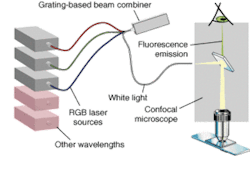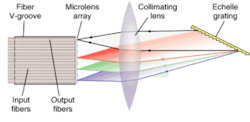Multiplexers adapt for instrumentation
Awide range of current and emerging applications for lasers use multiple wavelengths simultaneously. In many types of instruments, low-power visible laser sources such as semiconductor, diode-pumped solid-state, air-cooled argon-ion, and HeNe lasers are combined to provide an ultrabright white-light source to illuminate a biological sample, photographic film, or even television-like phosphors. Most often, it is left up to the instrument vendor to determine how to combine these lasers, which are typically supplied by different manufacturers. The instrument manufacturers resort to solutions that are tailor made for their application but can be expensive, not sufficiently rugged, and difficult to align.
Biotechnology instrument manufacturers, for example, frequently share similar requirements for their lasers. They require multiple visible wavelengths that may only be available from several different suppliers. Proper system function requires that the laser beams be perfectly co-aligned to propagate through the instrument optics to the sample. The light sources should be fiber coupled to facilitate field servicing. The optics required to combine the lasers should not introduce significant loss and should be stable with respect to temperature variations and vibration. The platform for beam combination must be expandable to other wavelengths but must retain high throughput with excellent out-of-band rejection (resistance to noise from neighboring excitation or emission wavelengths). Finally, the hardware should be sufficiently compact and inexpensive to fit a wide range of instrument sizes and price ranges. Finding a solution that meets this laundry list of requirements has been daunting indeed.
Existing technologies
Most instrument manufacturers use some combination of dichroic filters and bulk optics to combine multiple lasers into one beam. Such a platform is often difficult to align, especially when fiber-coupled laser light is desired. The slightest misalignment of a filter can cause significant loss of signal when fiber-coupling the filtered light. Excellent quality dichroic filters do exist, but as new wavelengths for advanced techniques emerge, new filters must be custom made and can be very costly. Systems involving several filters and optics are not only difficult to align but are sensitive to temperature variations and vibration and are rarely compact.
Other instrument manufacturers use systems based on acousto-optic tunable filters. These devices offer flexibility and modulation, but can be expensive and sensitive to vibration or temperature variations.
Adapted to DWDM
Dense-wavelength-division multiplexers (DWDMs) for telecommunications applications have overcome many of the same challenges that biotech instrument manufactures face. These devices have excellent stability, very low loss, and meet stringent requirements for out-of-band rejection (or crosstalk in telecom speak). They meet the rigorous demands of the Telcordia standard, which requires that products be rugged and thermally stable as well as able to operate in a wide variety of environments. Successful DWDM products are also compact, passive, and offer good value. Several DWDM technologies compete for telecommunications applications, including arrayed waveguides, thin-film filters, and diffraction-grating-based multiplexers.
Although thin-film-filter-based solutions are similar to the technology that most instrument designers currently use, adapting thin-film-filter telecommunications devices to other markets is expensive and offers few advantages. Arrayed waveguides offer good performance but are extremely costly to adapt to a new and shifting array of visible wavelengths present in biotechnology and photoreproduction.
Diffraction-grating-based multiplexers, on the other hand, can readily be adapted to a wide range of visible wavelengths (see Fig. 1). A platform developed at Zolo Technologies has high out-of-band rejection and is a completely passive optical element. Grating-based multiplexers have ultralow loss and high thermal stability in a low-profile package. These devices can be combined with emerging laser technologies such as semiconductor laser diodes and vertical-cavity surface-emitting lasers, which are relatively easy to modulate and fiber couple.
Biotech needs
Semiconductor, solid-state, and gas lasers are available in a wide range of visible wavelengths. Argon-krypton-ion lasers, HeNe lasers, and laser diodes populate the red spectrum with 633-, 647- and 650-nm wavelengths. Diode-pumped solid-state lasers deliver green at 532 nm, while a range of laser technologies in the blue spectrum produce 488, 473, 442, 420, and 405 nm. When used in a biotech application, typically one wavelength from each region is selected such that it efficiently excites a fluorophore without optically damaging the sample. Each excitation line is narrow so that it can be filtered from the fluorescence emission.
Biotech instruments are installed in the field, which is often a research laboratory or clinic. In such cases, optical technicians with the skills necessary to align sensitive optics are not readily available. Thus, any technologies used must be plug-and-play. With a fiber-coupled grating-based multiplexer, replacing a laser is a simple task. One needs only to remove the fiber connector from the combiner and attach the new laser, with no alignment necessary.
The design of the multiplexer is such that new wavelengths can be added with relative ease and without a total redesign of the device. Higher powers can be combined, provided they can be safely coupled into the optical fiber. Fiber coupling nominally limits the device power-handling capability to about 0.5 W total. In certain cases, somewhat higher powers can be accommodated. The design accommodates either single-mode or multimode fibers.
Color multiplexing
A grating-based multiplexer combines a high-performance ruled optical grating, free-space optics, micro-optics, and precision mounting in a hermetically sealed package. The gratings are manufactured using a subfringe-controlled ruling engine and specialized replication processes to ensure maximum diffraction efficiency and the necessarily high angular dispersion that yields a compact device. The multiplexer can be used in applications ranging from digital photo processing, in which equipment operates in a climate-controlled environment, to multispectral analysis in extremely hazardous environments, such as power plants or jet engines, where ruggedness and stability are critical.
Grating-based optical multiplexers can use several technologies to accomplish the multiplexing/demultiplexing function; however, echelle-grating-based multiplexers have the advantage of resulting in a very simple and compact design (see Fig. 2). Echelles are relatively coarse diffraction gratings that operate in orders other than first order with blaze angles typically above 45°. The coarse line spacing combined with high-order operation results in a large angular dispersion that allows the device to be compact.
Some telecommunications applications can require wavelengths other than those in the C-band (1525 to 1565 nm) to be simultaneously serviced by an optical multiplexer (for instance 1310 nm). Echelle-grating multiplexers provide unusual flexibility in this regard. For instance, our device is designed to operate in Littrow configuration in the sixth order. The grating equation for a Littrow mount is:
mλ = 2dsinθb
where m is the order, λ is the wavelength, d is the spacing between rulings, and θb is the blaze angle. For a given grating, the product mλ is a constant. For the Zolo grating, mλ = 9.27 µm. The grating can provide very high efficiency for other orders as well. For example, it can simultaneously multiplex C-band light as well as 1310-nm light with high efficiency. In general, the device has high diffraction efficiency for any wavelength that is nearly an integral divisor of 9.27 µm. For instance, 9.27 µm divided by 1.31 µm is approximately equal to 7, which accounts for the device's ability to diffract 1.31-µm light with high efficiency.
Spectroscopic applications exist outside telecommunications for multiplexing laser light at wavelengths separated by hundreds of nanometers. In these applications, it is critical for all beams to sample the same region of space and many wavelengths can be necessary to analyze species concentrations and temperatures. For these applications, echelle-grating-based multiplexers/demultiplexers provide a unique multiplexing solution. While it is unlikely that such a rugged multiplexer platform would have been developed for these new instrument applications, instrument designers can benefit from the technology investment that the telecommunications bubble created.
ANDREW SAPPEY is chief technical officer and RONALD ZIMMERMAN is sales and marketing manager, gratings, at Zolo Technologies, 4946 North 63rd St., Boulder, CO 80301; e-mail: [email protected] and [email protected].


